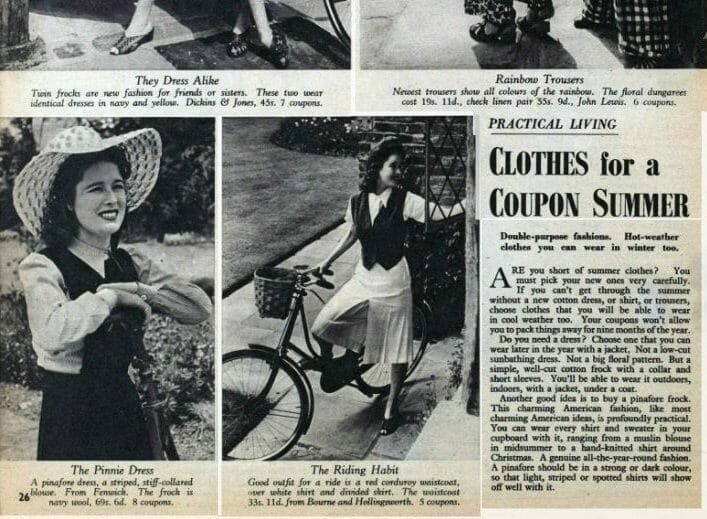From Coupons to Cocktail Dresses: Tracking Changes to Women's Wartime Fashion
The following ii tabs modify content below.
- Bio
- Latest Posts
I joined Gale in December 2014 as Digital Production Editor, working particularly on our Early on Standard arabic Printed Books from the British Library and Stuart & Cumberland Papers from the Royal Archives projects. I'm a qualified archivist and before joining Gale I worked in the Universities sector for nearly 10 years, so I'm delighted to continue working with Athenaeum and Academics in a office that has broadened my horizons and introduced me to new challenges.
The New year's day often brings a sense of "out with the sometime, in with the new". For the way-conscious, it's a skilful excuse to revamp ones wardrobe and get shopping. These days it'south like shooting fish in a barrel to buy new clothes every season, but it was very different during the Second World State of war. And so, clothing was rationed and had to be reused as much as possible. Once the state of war was over, the "out with the old" attitude finally prevailed over rationing, culminating in Christian Dior'south footing-breaking 'New Look'. I used Movie Post and other newspaper archives in Gale Artemis: Master Sources to rails changing attitudes to style in the newspapers and magazines of the time.
In June 1941 the British Lath of Merchandise introduced clothes rationing, granting an allowance of 66 coupons per household for the year. To near this meant having to "make do and mend", with women encouraged by President of the Board of Trade Hugh Dalton to deport a needle and thread with them at all times. Those who wanted to maintain their interest in fashion were required to retrieve creatively, resulting in designs that used less cloth and that were every bit versatile every bit possible. A spread in the Picture Mail service shows off designs that will final all year – light summer dresses with collars and sleeves for winter, and pinafore dresses that can be worn over shirts of whatsoever thickness.

Another Flick Postal service effect that month featured a coat that could convert into a bedspread!

Gradually practical, economic clothing became the norm, raising the hemline to save on material, and doing away with all embellishment.
Clothes rationing continued well beyond the war years, and even before peace was alleged patience with "make exercise and mend" was start to wear thin. Equally a writer for the Picture Post put information technology, "Naturally, women who have worn compatible, or patched for six years, want gay, pretty and essentially feminine clothes as soon as possible". Entrée Dior.
In 1947 Christian Dior was relatively unknown, designing for Lucien Lelong before launching his own collection that year. His new line, christened the 'New Wait', was an instant success. Feminine, elegant and using vast quantities of material, information technology was a far cry from the utilitarian wearing apparel that British women were used to.
The hemline dropped to well below the human knee, skirts were either very full or 'hobbled' women if they were pencil cut, and the tightly pinched-in waist became a defining feature. Practicality and economy had given mode to elegance and luxury.

The 'New Wait' was greeted with both excitement and vexation in United kingdom of great britain and northern ireland. Mary Delane, reporting from Dior's launch for the Sunday Times, said "The enthusiastic reception given to these supremely elegant apparel was well deserved… Dior's exquisitely swinging pleated skirts…have to be seen to be believed"3. Merely the excessive textile frustrated those who still had to abide by the restrictions of rationing. As a Picture Mail writer noted drily: "Paris forgets this is 1947". Many women preferred short hemlines, and began to look dorsum on the days of shorter skirts with nostalgia ("And so, a last await at the Sometime Look" Daily Mail [London] 29 Mar. 1948). American women were non keen on the longer skirts either ("Christian to confront the Amazons" Daily Post [London] 2 Sept. 1947), and eventually Dior bowed to pressure and introduced gowns with the same glamourous characteristics just with a shorter hemline. In doing so, the cocktail apparel was born.

0 Response to "From Coupons to Cocktail Dresses: Tracking Changes to Women's Wartime Fashion"
Post a Comment